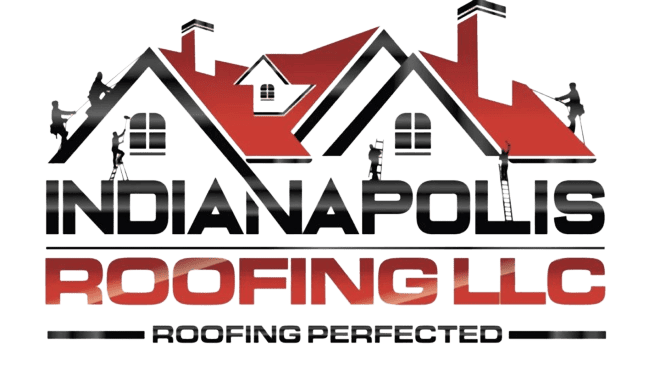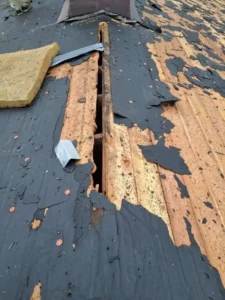Hail damage to a roof can cause serious structural issues and compromise the integrity of the entire system. In addition to visible dents and cracked shingles, hail damage can also lead to leaks and potential water damage inside the home.
It is crucial to address hail damage promptly to prevent further deterioration and ensure the safety and functionality of the roof. Roofs are constantly exposed to the elements and can be susceptible to various types of damage. One of the most common forms of damage is caused by hailstorms.

Hail can range in size from small pebbles to large golf balls, and when it pelts down on a roof, it can cause significant harm. This can include dents, cracks, and even punctures in the roof’s surface. Additionally, hail damage can weaken the shingles and expose the underlying materials to water infiltration, potentially leading to leaks and further water damage inside the home. Taking swift action to repair the hail damage is essential to prevent any further deterioration and maintain the structural integrity of the roof.
Table of Contents
ToggleIdentifying Hail Damage
Hail damage assessment can prove to be quite a challenge, as most individuals rarely venture onto their roofs. However, discerning hail damage is of utmost importance. In the aftermath of a hailstorm, being vigilant for the following indicators can help you identify potential damage:
- Shingle Impact: Examine your roof shingles for signs of damage caused by hail impact.
- Gutter Dents: Check if your gutters have been dented by hailstones.
- Garage Door Dings: Inspect your garage door for any dings resulting from hail impact.
- AC Unit or Grill Splatter Marks: Look for splatter marks on your air conditioning unit or outdoor grill.
- Car Dents: Check the top of your car for dents caused by hailstones.
- Exposed or Fractured Fiberglass Mat: Inspect your roof for exposed or fractured fiberglass mat, indicating potential hail damage.
- Painted Surface Damage: Assess other painted surfaces on your property for any signs of hail damage.
- Exterior Impact: Examine your property’s exterior for visible signs of hail impact.
- Granule Loss: Look for granules from asphalt shingles in your gutters, which might indicate hail damage.
- Downspouts and Window Sills: Inspect downspouts and window sills for any indications of hail impact.
- Exposed Metal Surfaces: Check for exposed metal surfaces that might have been affected by hail.
- Deck Damage: Examine your deck for any signs of damage resulting from the hailstorm.
- Dents, Punctures, and Holes: Differentiate between hail-induced dents, punctures, and holes from other forms of damage like blistering.
- Leaks and Water Stains: Be on the lookout for leaks, water stains, or wet spots inside your property that could be linked to hail damage.
If you spot any of these telltale signs of hail damage on your property, it is recommended to promptly schedule an inspection with a professional roofing contractor. Additionally, assessing the size of the hailstones during the storm can also provide valuable insights into the potential extent of hail damage. Taking these measures can help you mitigate further damage and ensure the longevity of your property’s roofing and structural integrity.
The Destructive Power Of Hailstorms
Hailstorms can cause extensive damage to roofs, regardless of their material or design. These storms are typically characterized by the presence of large, icy balls of precipitation falling from the sky. Some common causes of hailstorms include unstable atmospheric conditions and violent thunderstorms.
When hailstones impact a roof, they can puncture or crack shingles, dislodge granules, and even create dents in metal roofs. Different types of roofs are affected differently by hail damage. For instance, asphalt shingles may show signs of bruising or missing granules, while metal roofs may have visible dents or punctures.
It’s important to keep an eye out for signs of hail damage, such as discolored spots on shingles or leaks in the attic. Regular roof inspections and prompt roof repair can help mitigate further damage and protect the integrity of your roof.
Assessing The Severity Of Hail Damage
Assessing the severity of hail damage requires analyzing various factors. One important consideration is measuring the size and intensity of hailstones. Professionals use specific tools and techniques to accurately assess the damage. By determining the size of hailstones, they can estimate the impact on the roof’s integrity.
Additionally, the intensity of the hailstones plays a crucial role in assessing the extent of the damage. This includes considering the force with which the hailstones hit the roof and potential penetration. Overall, understanding these factors is essential for accurately evaluating the severity of hail damage.
By doing so, homeowners can make informed decisions regarding repairs or insurance claims. Trusting professionals with the expertise to assess hail damage is crucial for ensuring appropriate action is taken to protect roofs and property.

Effects Of Hail Damage On Different Roofing Materials
Hail damage can have significant effects on various roofing materials. For instance, asphalt shingle roofs can experience different types of damage, such as cracks and granule loss, which can lead to leaks and reduced lifespan. Metal roofs are vulnerable to dents and punctures from hail, requiring potential repair solutions such as panel replacement or dent repair.
On the other hand, tile roofs may suffer from structural integrity risks due to hail impacts, potentially resulting in cracks or fractures. Repair considerations for tile roofs include assessing the extent of damage and replacing individual tiles as needed. It is crucial to address hail damage promptly to ensure the longevity and functionality of your roofing material.
Regular inspections can help detect and address any issues caused by hailstorms.
The Roof Inspection Process After A Hailstorm
After a hailstorm, it is crucial to conduct a comprehensive visual inspection of your roof. Engaging a professional roof inspector has numerous benefits. They possess the expertise to identify even minor hail damage that may not be visible to the untrained eye.
These experts can accurately assess the extent of the damage and provide a detailed report to guide the repair process. By taking immediate action, you can prevent further deterioration of your roof and save money in the long run. By investing in a professional inspection, you can ensure that all necessary repairs are addressed promptly and effectively.
It is important to remember that hail damage can worsen over time, leading to more extensive and expensive repairs if not addressed promptly. So, don’t delay in contacting a professional roof inspector after a hailstorm to safeguard the structural integrity of your home.
Navigating The Insurance Claims Process
Navigating the insurance claims process for hail damage roof requires gathering comprehensive documentation. Understanding your policies’ terms and conditions is important. Negotiating with insurance adjusters is necessary to ensure fair coverage for the damage incurred. By providing detailed evidence and accurately assessing the extent of the damage, you can increase the chances of a successful insurance claim.
Remember to document everything, from photographs of the roof to estimates from contractors. Communicate effectively with your insurance company, asking questions and clarifying any uncertainties. It’s important to advocate for yourself and ensure that you receive the compensation you deserve.
With proper documentation and effective negotiation, you can navigate the insurance claims process with confidence.
Common Hail Damage Roof Repairs And Restoration Methods
Hail damage can wreak havoc on roofs, resulting in various repairs and restoration methods. Damaged shingles require repair and replacement if missing. Metal roofing with dents and punctures can be addressed with suitable solutions. Cracked or broken tiles should be replaced, while also identifying and fixing any underlying issues.
Correcting these damages promptly is crucial to prevent further problems. Maintenance plays a significant role in preserving the integrity and durability of the roof. Regular inspection and addressing issues promptly can help extend the lifespan of the roof, avoiding costly repairs in the long run.
Professional assistance should be sought in more severe cases of hail damage to ensure comprehensive repairs and restoration. Understanding the common repairs and restoration methods for hail-damaged roofs is essential for homeowners and property owners alike to maintain the structural integrity of their roofs.
Preventative Measures To Mitigate Future Hail Damage
To protect your roof from future hail damage, it is important to take preventative measures. One effective step is to consider installing impact-resistant roofing materials. These materials are designed to withstand the impact of hail and minimize potential damage. Another key strategy is to implement regular maintenance checks on your roof.
By identifying any weak spots early on, you can address them before they become a major problem. Hiring a professional roofing inspector can play a crucial role in this prevention process. These experts have the knowledge and experience to identify areas that may be vulnerable to hail damage and provide recommendations on how to mitigate the risk.
By taking these proactive measures, you can protect your roof and avoid costly repairs down the line.
Hiring A Reliable Roofing Contractor For Hail Damage Repairs
Hail damage on a roof requires a reliable roofing contractor who possesses the necessary credentials and certifications. Assessing the contractor’s qualifications is crucial to ensure a quality repair job. One should look for certifications such as haag certification, which guarantees expertise in assessing storm damage.
Additionally, obtaining multiple cost estimates from different contractors allows for comparison and helps in choosing the most reasonable option. It is important to gather as much information as possible about the contractor’s previous work, reviews, and references to make an informed decision.
Hiring a reputable roofing contractor ensures that the hail damage repairs are done efficiently and effectively, ensuring the longevity and safety of the roof.
Frequently Asked Questions Of Hail Damage Roof
Can Hail Damage Cause A Leak In My Roof?
Yes, hail damage can cause a leak in your roof. When hail hits your roof, it can cause shingles to crack or become dislodged, creating openings for water to seep in. It’s important to inspect your roof for any damage after a hailstorm and promptly address any issues to prevent leaks.
How Can I Tell If My Roof Has Been Damaged By Hail?
To determine if your roof has been damaged by hail, look for signs such as cracked or missing shingles, dents or dimples on metal roofs, or granules from shingles in your gutters. You can also hire a professional roofing inspector to perform a thorough assessment and provide an expert opinion.
What Should I Do If My Roof Has Hail Damage?
If your roof has hail damage, it’s important to take action to prevent further problems. Contact a reputable and affordable roofing contractor to inspect the damage and provide a roof repair or roof replacement estimate. Also, document the damage with photographs and contact your insurance company to initiate a claim, as hail damage is often covered by homeowners insurance.
Lastly
Experiencing hail damage to your roof can be a stressful situation, but it’s essential to take prompt action to prevent further problems. Identifying the signs of damage, such as cracked shingles or dented metal, is crucial in determining the need for repair or replacement.
Hiring a professional roofing contractor is highly recommended as they have the expertise to assess the extent of the damage accurately. Taking pictures of the damage and contacting your insurance provider are important steps towards filing a successful claim. Remember, addressing hail damage promptly can save you from more significant issues down the road, such as leaks or structural damage.
By following these guidelines and enlisting the help of professionals, you can restore the integrity and longevity of your roof and ensure the safety of your home for years to come.






